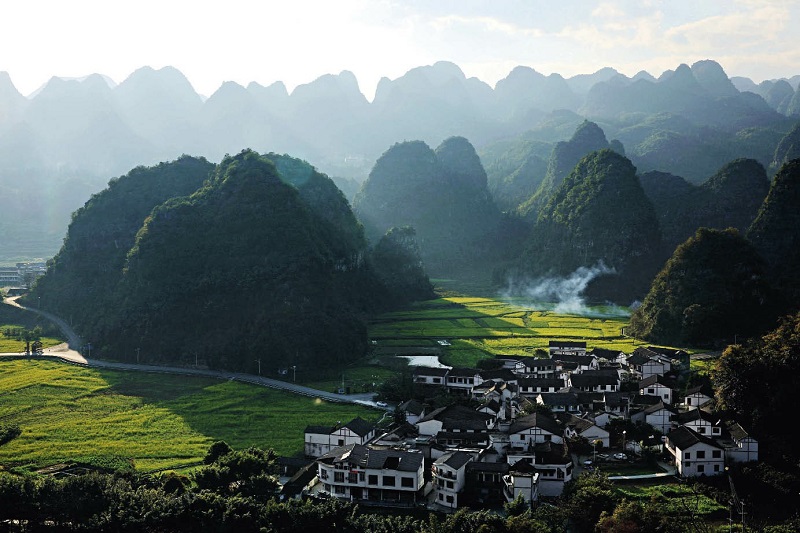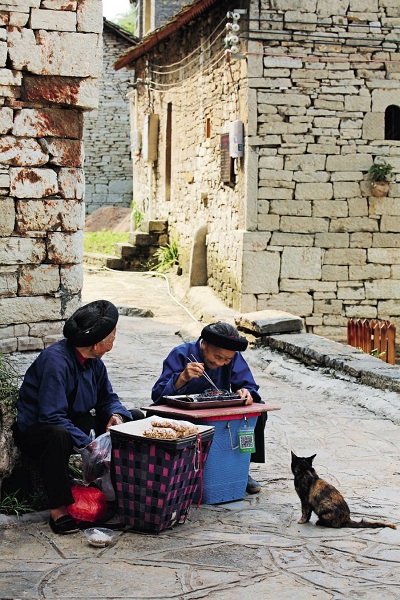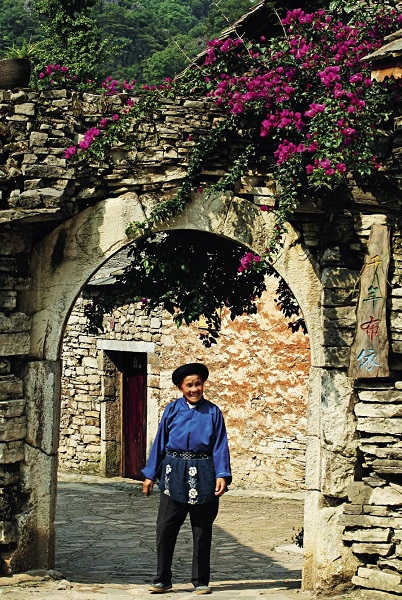
Wanfenglin Scenic Area located in Xingyi City, Qianxinan Bouyei and Miao Autonomous Prefecture is known as one of the most beautiful karst landforms in the world.
The Eight Trigrams Field
The peak forest enshrouded by natural beauty includes a chain of mountain peaks that are surrounded by golden colored fields, bubbling rivers, quaint villages, lush trees, and winding roads. Wispy lines of smoke can also be seen rising from kitchen chimneys during misty mornings.
The cultivated fields at the foot of the Wanfenglin peak forest do not have a traditional design. The famous Eight Trigram field looks like a wide and shallow funnel-disk with a funnel at the center. The farmland is cultivated around the funnel, creating a shape that looks like the eight trigram symbol (bagua) from ancient Chinese philosophy.
The aforementioned symbol was once very influential in ancient Chinese culture, but its origin has always been shrouded in mystery. Up until now, no one has been able to decipher the diagrams backed by scientific evidence. As a result, people began to ascribe supernatural powers to it with the passage of time. In the end, the appearance of the eight trigrams here signifies that this land is mysteriously protected by the power contained in the eight trigrams.
The eight-trigram field in Wanfenglin is made up flowers, grass, water, and light. According to a Taoist tale, there once was a Taoist monk named Li who fought a battle of mind and body with the ferocious mountain demon who was always troubling and harming local people. Li overcame the demon by using this Taoist treasure. As the monk rotated the eight trigram abacus, mysterious rays of light shone in all directions leading to the creation of all living creatures. The yin and yang at the center of the eight trigram became the celestial eye, and the exterior eight sections expanded until they filled the whole area. Since then, local residents have enjoyed a happy life surrounded by beautiful forests, with ample annual rainfall for crops, and large herds of healthy livestock.

Two Bouyei women in Gaodang Village.
The Funnel Group of Nahui
There are nearly 40 plots of funnel-centered farmland in Nahui Village which are referred to as a “funnel group.” The funnels are formed by a partial collapse of underground rivers and surface water erosion. The funnel group of Nahui shows an orderly zonal distribution, and an underground river is covered by vegetation. There are two rivers, the Nahui River which is visible above ground, and an invisible river that is underground. As if by magic, the Nahui River flows along the surface of the ground for a distance, then suddenly and inexplicably disappears underground without a trace, only to appear again more than 20 kilometers away.
Local people cultivate fields to grow crops all around the funnel in the center. Most fields have an arc-like shape. In addition, they also have built curved aqueducts to bring water from underground to irrigate the fields. During rainy seasons, flood water quickly drains into the funnel, while in times of drought, water from the underground river can be diverted to irrigate the farmland. In the words of a local plowman, “Wanfenglin ensures stable yields and good harvests despite droughts. We have never experienced flooding here!”
The funnel in the fields near Xianahui Village resembles the human eye. It is known as the “Earth eye.” According to local people’s belief, mother Earth watches over her countless number of children with her powerful eye, as they work hard to plow and plant the fields. They believe that this Earth eye is connected with the heavens, understands and remembers all their joys, sorrows, and sighs. It also protects them. This “earthly eye” is similar to other funnels in that the lower part of the funnel is connected with the underground river, which passes through very complicated and rough topography that even today people have not mapped out fully nor accurately gauge the speed of the flow of water. The group of connected funnels that connect to the underground river are scattered around the mysterious and stunning Wanfenglin region.
Bouyei Ethnic Minority Villages
Bouyei (an ethnic minority group) villages in the Wanfenglin region are nestled between the mountains and rivers. These villages are named according to their location with respect to the Nahui River. There is the Shangnahui Village (Upper Nahui), Zhongnahui Village (Middle Nahui), and Xianahui Village (Lower Nahui). There is another village near the farmland that is shaped like the moon and thus is called Yueliang Village (Moon Village).
Bouyei people have a long history of growing rice. There are Bouyei communities located throughout China’s southwestern provinces, but the majority of them are located in Guizhou Province. They speak their own language. They once had a written form of their language, but later it slowly disappeared throughout its long history.
The word “Nahui” in the Bouyei language means beautiful paddy fields. Bouyei people love water. The Nahui River zigzags back and forth through the northwestern area of the peak forest, passing by stone bridges and villages. Along the river banks, there lie forests of tall bamboo blowing in the wind, green plantain, small yellow flowers, weathered gray stone steps, bamboo rafts hidden among huge tree roots, and old men and women carrying baskets of things to wash at the river banks. Bouyei people have lived a self-sufficient farming life in the Wanfenglin region and passed on their local culture for many generations. The increasing number of tourists to the region over the last several years has brought business opportunities. Bouyei people provide food and accommodation services for tourists. Many villages have even replaced their old houses with reinforced concrete buildings.
The Nahui River is more than 20 kilometers long, having clear water flowing from north to south crisscrossing through the maze of Wanfenglin forest peaks. Ancient trees are found all over Xianahui Village near the river. The Bouyei people respect nature and never cut down trees that have been growing for more than several decades. Villagers wrap a red handkerchief of blessing around older trees, and light incense and fireworks to exemplify just how much the Bouyei people respect, love, and deify the ancient trees.
There is an open-air market near the ancient trees in Xianahui Village. On holidays, Bouyei people from nearby villages come to trade with agricultural produce and by-products. An elderly person sells deep valley orchids and wild dendrobium under the shade of the banana trees on the road side near the market. The seller enjoys smoking his long-stemmed pipe while waiting for customers. In the market, people laugh and chat about prices. Few people can be seen wearing traditional Bouyei clothes except for the occasional elderly woman who wears black headdress.
Gaodang Village in Anshun City is one of the few well preserved ancient Bouyei villages in Guizhou Province. The stilt-styled traditional architecture were built in the Ming and Qing (1644-1911) dynasties. During the Qing Dynasty, there were fortresses positioned high up on the mountain peaks surrounding the village to protect the village people.
Costumes, architecture, and folklore of these Bouyei villages have never been assimilated with the Han ethnic culture. When entering the village, visitors soon realize that almost everything is made from stone, including archways, streets, walls, roofs, houses, hearths, mills, tables and stools, and jars. Local stone houses are weatherproof, with simple, beautiful, and durable structures that have been passed down from generation to generation. Looking at the village from an aerial view, the stone roofs are neatly laid out in diamond-like shapes or spread out in the pattern of fish scales; the houses are surrounded by green fields, with the Suoluo River flowing by.
In this ancient village, old Bouyei people sit in groups of two or three selling their own edible wares. Local cats and dogs roam through the village very quietly. Only the calls of roosters strutting around break the serene silence from time to time. There are five stone arch doors in the village, creating independent communities within the village. An ancient castle is built on the high rock cropping to the east of the village, and a military outpost was built on the mountain in front of the village similar to ancient castles, providing the whole village fortification if in a state of alert. During the middle and late Qing Dynasty, Guizhou was regularly plagued by social unrest and was often attacked by bandits. Throughout history, many villages built military fortresses, but few of them survived to this day.

A local resident walks through a well preserved historical village of the Bouyei ethnic minority.
Towering Rock Formations
Among the peaks of Wanfenglin, there stands out a towering one called Jiangjun (General) stone formation.
According to legend, an ancient Chinese deity called the Erlang Shen vanquished demons from the area. He is believed to be the god that is involved in water conservation, farming, and flood prevention. Erlang Shen suppressed the water monster in the Wanfenglin region, and fearing it would hurt local people again, incarnated himself into a karst rock pinnacle. Putting aside the fairy tale, from a geological perspective, the Jiangjun rock formation is a prehistoric monument with thousands of years of geological vicissitudes clearly visible on its impressive facade. It is a record of the entire history of karst geological changes for thousands of years.
About 360 million years ago, there was a vast expanse of water here in Xingyi. Then about 280 million years ago, dry land started to form during the Carboniferous period. As the result of multiple orogenic movements, the earth’s crust began to rise higher and higher, creating mountain peaks. Later after a long period of constant corrosion, the unique geomorphological features of the Wanfenglin peaks which we see today emerged.
There is abundant beauty to be witnessed in the Wanfenglin area during every season. During spring, there is a transformation in the natural world from yellow to green with the emergence of new life. With the arrival of summer, the mountains are lushly green. In the fall, there is a joyful harvest, and during winter months, people are busy planting crops during the warm days. During rainy weather, mist and clouds are beautiful, and the distant mountains, green trees, yellow flowers, gold, and brown fields all spring to life. In foggy weather, the rocky peaks are concealed, distant ridges become fuzzy, and cottages look like pictures from fairy tales. When the sky is filled with clouds, they float across the sky like balls of cotton, caressing the mountains, winding through tree tops and across rivers, and chase after farmers. When there are clear blue skies with visibility stretching far into the horizon, one can see thousands of peaks, a brilliant countryside, and farmers carrying on with their tranquil daily lives.
ZHAO YANQING is a travel columnist.








